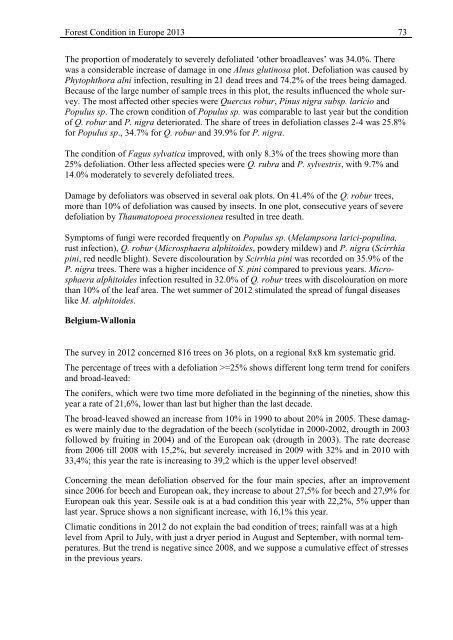Forest Condition in Europe - ICP Forests
Forest Condition in Europe - ICP Forests
Forest Condition in Europe - ICP Forests
Create successful ePaper yourself
Turn your PDF publications into a flip-book with our unique Google optimized e-Paper software.
<strong>Forest</strong> <strong>Condition</strong> <strong>in</strong> <strong>Europe</strong> 2013 73<br />
The proportion of moderately to severely defoliated ‘other broadleaves’ was 34.0%. There<br />
was a considerable <strong>in</strong>crease of damage <strong>in</strong> one Alnus glut<strong>in</strong>osa plot. Defoliation was caused by<br />
Phytophthora alni <strong>in</strong>fection, result<strong>in</strong>g <strong>in</strong> 21 dead trees and 74.2% of the trees be<strong>in</strong>g damaged.<br />
Because of the large number of sample trees <strong>in</strong> this plot, the results <strong>in</strong>fluenced the whole survey.<br />
The most affected other species were Quercus robur, P<strong>in</strong>us nigra subsp. laricio and<br />
Populus sp. The crown condition of Populus sp. was comparable to last year but the condition<br />
of Q. robur and P. nigra deteriorated. The share of trees <strong>in</strong> defoliation classes 2-4 was 25.8%<br />
for Populus sp., 34.7% for Q. robur and 39.9% for P. nigra.<br />
The condition of Fagus sylvatica improved, with only 8.3% of the trees show<strong>in</strong>g more than<br />
25% defoliation. Other less affected species were Q. rubra and P. sylvestris, with 9.7% and<br />
14.0% moderately to severely defoliated trees.<br />
Damage by defoliators was observed <strong>in</strong> several oak plots. On 41.4% of the Q. robur trees,<br />
more than 10% of defoliation was caused by <strong>in</strong>sects. In one plot, consecutive years of severe<br />
defoliation by Thaumatopoea processionea resulted <strong>in</strong> tree death.<br />
Symptoms of fungi were recorded frequently on Populus sp. (Melampsora larici-popul<strong>in</strong>a,<br />
rust <strong>in</strong>fection), Q. robur (Microsphaera alphitoides, powdery mildew) and P. nigra (Scirrhia<br />
p<strong>in</strong>i, red needle blight). Severe discolouration by Scirrhia p<strong>in</strong>i was recorded on 35.9% of the<br />
P. nigra trees. There was a higher <strong>in</strong>cidence of S. p<strong>in</strong>i compared to previous years. Microsphaera<br />
alphitoides <strong>in</strong>fection resulted <strong>in</strong> 32.0% of Q. robur trees with discolouration on more<br />
than 10% of the leaf area. The wet summer of 2012 stimulated the spread of fungal diseases<br />
like M. alphitoides.<br />
Belgium-Wallonia<br />
The survey <strong>in</strong> 2012 concerned 816 trees on 36 plots, on a regional 8x8 km systematic grid.<br />
The percentage of trees with a defoliation >=25% shows different long term trend for conifers<br />
and broad-leaved:<br />
The conifers, which were two time more defoliated <strong>in</strong> the beg<strong>in</strong>n<strong>in</strong>g of the n<strong>in</strong>eties, show this<br />
year a rate of 21,6%, lower than last but higher than the last decade.<br />
The broad-leaved showed an <strong>in</strong>crease from 10% <strong>in</strong> 1990 to about 20% <strong>in</strong> 2005. These damages<br />
were ma<strong>in</strong>ly due to the degradation of the beech (scolytidae <strong>in</strong> 2000-2002, drougth <strong>in</strong> 2003<br />
followed by fruit<strong>in</strong>g <strong>in</strong> 2004) and of the <strong>Europe</strong>an oak (drougth <strong>in</strong> 2003). The rate decrease<br />
from 2006 till 2008 with 15,2%, but severely <strong>in</strong>creased <strong>in</strong> 2009 with 32% and <strong>in</strong> 2010 with<br />
33,4%; this year the rate is <strong>in</strong>creas<strong>in</strong>g to 39,2 which is the upper level observed!<br />
Concern<strong>in</strong>g the mean defoliation observed for the four ma<strong>in</strong> species, after an improvement<br />
s<strong>in</strong>ce 2006 for beech and <strong>Europe</strong>an oak, they <strong>in</strong>crease to about 27,5% for beech and 27,9% for<br />
<strong>Europe</strong>an oak this year. Sessile oak is at a bad condition this year with 22,2%, 5% upper than<br />
last year. Spruce shows a non significant <strong>in</strong>crease, with 16,1% this year.<br />
Climatic conditions <strong>in</strong> 2012 do not expla<strong>in</strong> the bad condition of trees; ra<strong>in</strong>fall was at a high<br />
level from April to July, with just a dryer period <strong>in</strong> August and September, with normal temperatures.<br />
But the trend is negative s<strong>in</strong>ce 2008, and we suppose a cumulative effect of stresses<br />
<strong>in</strong> the previous years.
















